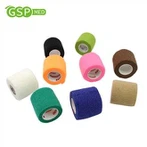
FAQ: Kinesiology Tape
Q: What is kinesiology tape?
A: Taping is a decades-old rehabilitation strategy used by physical therapists, chiropractors, personal trainers, athletic trainers and other health professionals to promote healing. One of the most popular tapes on the market is Kinesio Tape, a non-latex, cotton tape that stretches with your body. It’s breathable, water-resistant and lasts on your skin for three to five days — even as you shower, ice injuries and engage in regular activities.
Q: How does it work?
A: Tape supports the body’s natural healing process by microscopically lifting layers of skin. This microscopic lifting stabilizes muscles and tissues, helps your lymph system drain excess fluid and reduce swelling. But unlike traditional athletic tape, it doesn’t restrict mobility. Depending how you apply the tape, it can even enhance your range of motion. The tape serves as a sort of tactile cue for the muscles to fire. In fact, many athletes rely on tape to support injured muscles and protect the joints.
Q: What is it used for?
A: Tape can be used for almost any ailment from headaches to low back pain. You can even use it to draw out a splinter. But most people use tape to reduce pain and enhance performance. The shape, direction and amount of stretch placed on the tape — along with the duration of time it sits on the skin — combine to achieve the desired goal. Used correctly, tape can also help re-educate the neuromuscular system.
Common goals of tape:
Improved range of motion
Reduced pain and swelling
Support and stability
Scar tissue management
Q: Can you feel it?
A: Most people who wear kinesiology tape can’t feel it after the initial application. The tape is elastic, so it moves with your body. In that sense, it feels much different than athletic tape, which often has the sensation of pulling your body in a certain way.
Q: Who should NOT use kinesiology tape?
A: In general, tape is safe to use for almost anyone. However, if you have cancer, an open wound or an active infection, you should avoid tape until those issues resolve. Tape works with your lymphatic system and increases circulation, so it could make some of those conditions worse.
Q: Are there any risks or drawbacks to using kinesiology tape?
A: If you pull too hard on the tape – and make it too tight – you can blister and tear your skin. That’s why it’s important to work with a trained professional rather than apply the tape on your own. (See below for application tips). The direction and the amount of stretch makes a huge difference.







